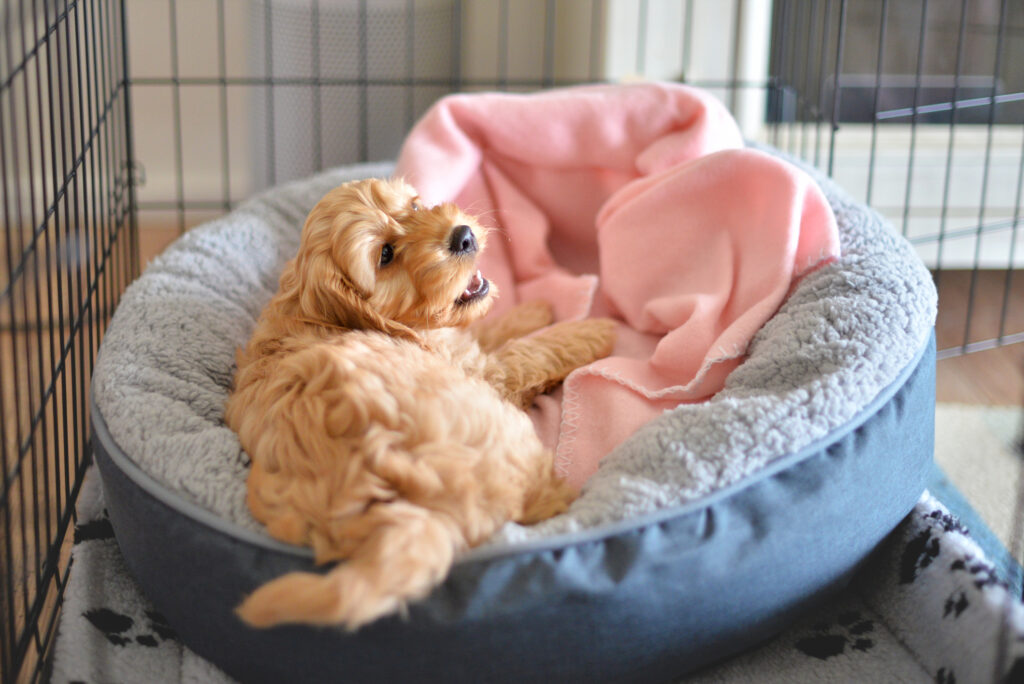How to Successfully Implement Dog Crate Training
Dog crate training is a very efficient way to provide a secure and comfortable space for your furry buddy while also assisting in their overall behavioral growth. When executed properly, crate training can serve as an effective device in housebreaking, dealing with separation anxiety, and providing a secure environment for your dog. In this article, we will discuss the key steps to successfully carry out dog crate training, ensuring an assured experience for both you and your canine companion.
Choose the Right Crate
Selecting the right crate is important for the success of crate training. The crate should be sizeable enough for your dog to stand, roam around, and set down easily. However, it should not be too sizable as it may promote urinating in one corner and sleeping in the other.
Various Crate Types
While finding a crate will be easy, some types of crates may fit your needs better than others.
Wire Crates
Wire crates are popular and widely used due to their durability and ventilation. They are normally made of metal wires, providing an open and airy environment for your dog.
Plastic Crates
Plastic crates, also referred to as airline crates, are strong and offer more seclusion and security compared to wire crates.
Soft-Sided Crates
Soft-sided crates are lightweight and convenient choices that are popular for their accessibility and ease of relocation.
Heavy-Duty Crates
Heavy-duty crates are created for powerful and persistent dogs or those prone to escaping.
Exercise Pens
These pens are typically made of metal panels that are interconnected to form an enclosed space.
Introduce the Crate Gradually
To make the crate a joyful and peaceful space for your pup, introduce it gradually. Start by placing the crate in a location where your dog passes most of their time.
Give a treat
Motivate your dog to enter the crate willingly by putting treats near the doorway. Repeat this process several times, progressively placing the treats further and deeper into the crate. Make the crate a positive and inviting space by placing goodies, toys, or a cozy bed inside.
Create a Positive Association
Connecting the crate with positive experiences is necessary. Begin feeding your dog near the crate, gradually relocating the food bowl closer to the doorway, and finally inside the crate. This will help your dog associate the crate with mealtime and develop pleasant associations.
Gradual Enclosure
Once your dog feels secure and enters the crate voluntarily, steadily close the door for a short period while they are inside and step by step increase the duration. Stay close throughout this process to provide support and avoid any worry or distress. Stretching the time will help your dog develop endurance and patience for being inside the crate.
Establish a Routine
Crate training relies significantly on consistency. Setup a schedule for your dog’s crate time, which must include regular meals, free time, and stool breaks. Dogs thrive on routine, so following the pattern will help them adapt to the crate more easily. Avoid using the crate as a form of punishment.
Supervision
During the primary stages of crate training, it’s essential to oversee your dog when they are inside the crate. This enables you to respond quickly to any signs of distress, anxiety, or pain.

Avoid Overuse
Once your dog has become familiar with crate training, it’s important to refrain from using the crate too frequently or unnecessarily. Misusing the crate can lead to dependency or isolation issues. Step by step increase their freedom and approach to other areas of the house, allowing them to develop belief and independence.
Negative Associations
Using the crate as a form of punishment can create negative associations and hamper the value of crate training. The crate should always be correlated with positive events, relaxation, and security. Avoid driving or punishing your dog into the crate, as this can create fear or resistance towards it.
Inadequate Potty Training
Dogs need regular outdoor toilet breaks and urinate in designated areas. Using the crate as a tool for potty training should be complemented with a well-designed toilet routine.
Safety Considerations
Make sure that the crate is stationed in a secure area of your home, away from potential dangers or extreme temperatures. Take off any collars or tags that could become tangled in the crate. Avoid placing the crate near things that your dog could crack over.
Supervise and Gradually Increase Alone Time
When you feel confident that your dog is comfortable in the crate, start leaving them alone for short periods. Begin with brief absences, such as stepping out of the room, and gradually increase the duration over time. Ensure your dog has toys or chews to keep them occupied during alone time, reducing any potential anxiety or boredom.
Patience and Positive Reinforcement
Crate training takes time and patience. Remember to reinforce positive behavior with praise, treats, and rewards. Avoid scolding or punishing your dog if they show reluctance or anxiety towards the crate, as this can create negative associations. Stay consistent and encourage positive experiences to help your dog feel secure and comfortable in their crate.
Key Advantages of Dog Crate Training
Crate training has many benefits to pet parents.
Safety and Security
Crate training provides a safe and secure space for your dog when you’re unable to directly watch them. It helps prevent mishaps, such as chewing on harmful objects or consumption of toxic substances. Crates can also serve as a safe sanctuary during traumatic situations like thunderstorms or fireworks.
Housebreaking and Control
Crate training is helpful in housebreaking or toilet training for your dog. Dogs have a natural tendency to keep their sleeping quarters clean, so a right-sized crate can aid in developing bladder and bowel control.
Establishing Boundaries
A crate serves as a physical boundary for your dog, teaching them to respect limits within your home. It helps prevent destructive behaviors, such as excessive chewing or scratching furniture, by providing a designated space where they can rest and relax without causing damage.
Travel and Transportation: Crate training prepares your dog for traveling in a crate, whether it’s for short car rides or longer journeys. Dogs that are comfortable in their crates are less likely to experience anxiety or stress during transportation.
Behavioral Management
Crate training can help manage and fix certain behavioral problems. For example, if your dog tends to show separation anxiety, the crate can provide a safe shelter and make them feel at ease when left alone. Crates can also be useful for managing hyperactivity, excessive barking, or overexcitement by giving your dog a tranquil and secure space to unwind in.
Facilitating Training and Structure
Crate training facilitates other forms of training and obedience exercises. Dogs that are comfortable in their crates are more focused and receptive to learning. The structured environment of the crate helps establish a sense of routine, discipline, and self-control, which can be extended to other aspects of their behavior and training.
Vet Visits and Recovery
Familiarity with crates eases the process of veterinary visits and medical procedures. Many veterinary clinics and hospitals require dogs to be crated during examinations or treatments. Crate training reduces stress and anxiety during these visits, making it easier for veterinarians to provide care. It also aids in post-operative recovery by restricting movement and promoting a calm healing environment.
Conclusion
Implementing dog crate training can greatly benefit both you and your four-legged companion. With the right approach, patience, and positive reinforcement, you can successfully introduce the crate as a safe and comfortable space for your dog.
Looking for a veterinarian to help with dog crate training near Tewksbury, MA? Contact Shawsheen Animal Hospital. Our vets are experts at canine behavior and can help you during this transitional period. Call us today at (978) 851-5558, or Request an Appointment online.





